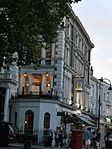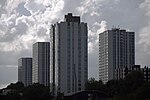Adelaide Nature Reserve
Local nature reserves in Greater LondonNature reserves in the London Borough of Camden

Adelaide Local Nature Reserve is in North West London, in the area of Chalk Farm, Primrose Hill, Belsize Park and Swiss Cottage. It is managed by a local volunteer group, the Adelaide Nature Reserve Association, which works with the council to improve the site for wildlife and local community use and enjoyment. The site is a Local Nature Reserve and Site of Borough Importance for Nature Conservation, Grade 1.
Excerpt from the Wikipedia article Adelaide Nature Reserve (License: CC BY-SA 3.0, Authors, Images).Adelaide Nature Reserve
Adelaide Road, London Chalk Farm (London Borough of Camden)
Geographical coordinates (GPS) Address Nearby Places Show on map
Geographical coordinates (GPS)
| Latitude | Longitude |
|---|---|
| N 51.54382 ° | E -0.161319 ° |
Address
Cleaver House
Adelaide Road
NW3 2BN London, Chalk Farm (London Borough of Camden)
England, United Kingdom
Open on Google Maps








